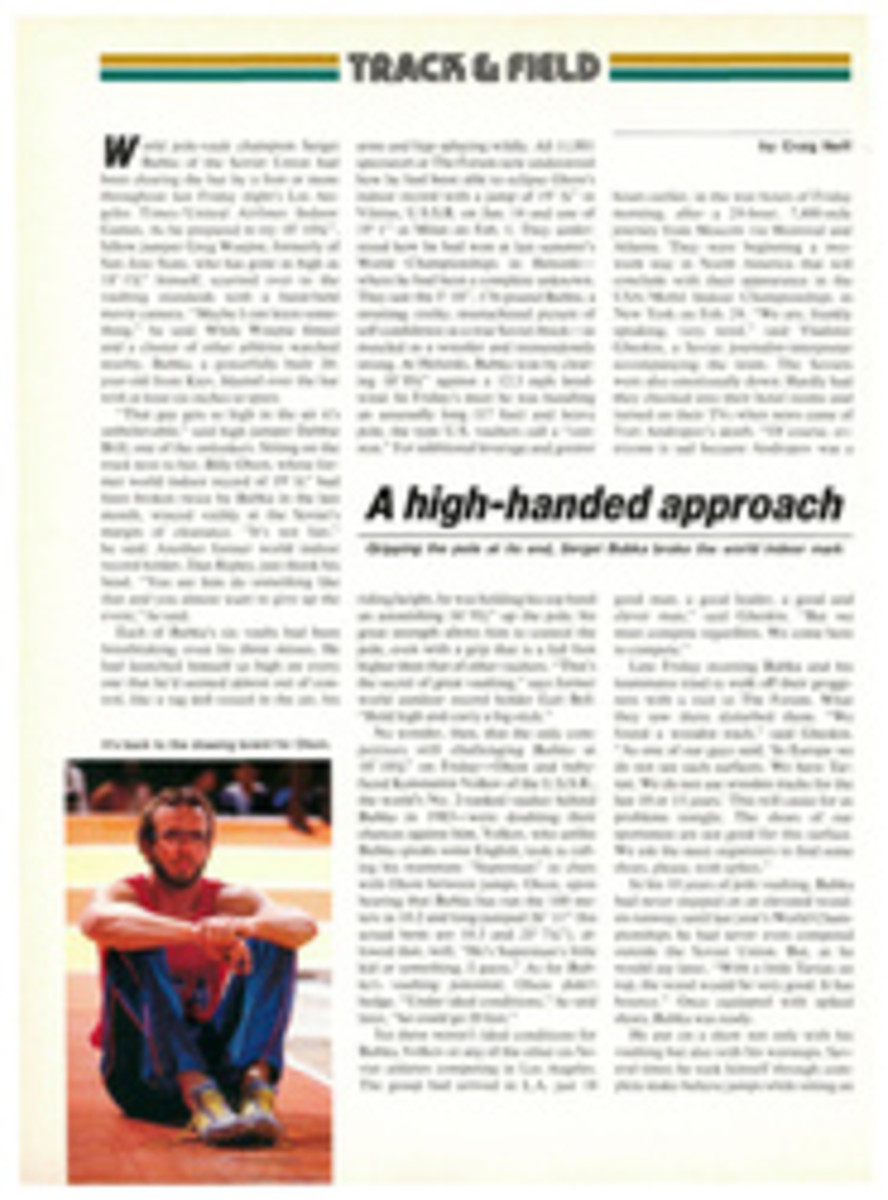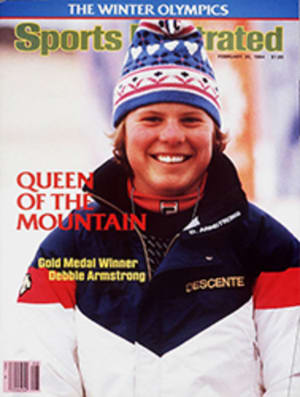
The U.S. Found A Silver Lining
A modest fanfare would be appropriate, preferably followed by something like The Stars and Stripes Forever. No, make it The Stars and Stripes at Last, for we are about to present—tadah!—the first medals to be awarded to Americans at the 1984 Winter Games. They were silver, but they glistened like gold because, for day after worrisome day last week, it seemed that the U.S. might not see any medals of any metal.
But there they are, shining softly and draped around the necks of the brother-and-sister figure skating pair of Kitty and Peter Carruthers of Burlington, Mass., who came in from the snow on Sunday night and did something other U.S. athletes were having a decidedly hard time doing, succeeding beyond their expectations. Not only were the Carrutherses' medals the first for America in Sarajevo, but they also were the first silver for the U.S. in pairs skating since the 1952 Olympics in Oslo. The mighty Elena Valova and Oleg Vasiliev, the world champions from the U.S.S.R., won the gold medal, and properly so, for they skated cleanly throughout the two days of competition. The bronze went to the No. 2 Soviet team of Larissa Seleznyova and Oleg Makarov, who had begun the finals tied with the Carrutherses.
The Carrutherses had entered the competition, which began with the short program on Friday, as America's national champions and ranked fourth in the world. To win a gold medal they had to defeat 13 other pairs—well, 14, counting the Chinese tandem, which could only be considered cute at best—headed by Valova and Vasiliev. Further, Kitty had spent the preceding four days suffering from painful tendinitis in her right ankle. To ease the pain she wrapped her ankle with foam rubber and used her skate boot as a sort of brace. "I thought I'd bust," she said, referring to how tightly she laced the boot.
But the ankle—it's the one she lands on when Peter throws her all over town—held up, and in Sunday's freestyle showdown, the Carrutherses skated what will likely become known as the Big Barn-Burner in the Balkans. Indeed, when their 4½ minutes were over, instead of saluting the judges as figure skaters traditionally do, they fell into a happy bear hug in the center of the ice. The entire house of some 8,000 onlookers stood and cheered them.
To be sure, few nights in figure skating have been as emotion charged as Sunday. Here's a prime example: Seleznyova and Makarov skated 12th in the field, with the U.S.S.R.'s champions up next, followed by the Carrutherses. The No. 2 Soviets came on strongly, as promised, so strong that hearts began to sink in the rowdy pro-American crowd. But then, amazingly, Seleznyova stepped clumsily out of the second jump of a double combination, and suddenly, with any luck, the silver belonged to the Carrutherses. In fact, several madcaps leaped to their feet in the middle of the Soviets' number and screamed, "Ball game, that's the goddam ball game!" Heavens, one doesn't do that sort of thing in figure skating. Still, Seleznyova and Makarov finished with a perfectly respectable score full of 5.7s (of a possible 6.0), which meant that the Carrutherses were hardly a shoo-in for the silver.
Before going on the ice, a thoroughly hyped-up Peter nudged his and Kitty's coach, Ron Ludington, and said, "This is going to be it." In the few moments that followed, they put on what Ludington later called "one of the most electrifying performances I ever saw." They skated like mirror images, except for those heart-stopping seconds when Kitty was twirling high in the overhead lights, somehow landing as smoothly as a feather on every jump, every throw, every spin. They, too, earned a heap of 5.7s and, by the narrowest of margins, second place. Then came the aforementioned hug and the medals.
While the finals contained plenty of drama, there were a few moments earlier in the week when it appeared that the Carrutherses would show up at the Zetra and unload their secret weapon, the Big Quad. This stunt is a dizzying advance over their throw triple Salchow; in the quad Kitty whirls through four full airborne left turns. No one, not even the Soviets, has ever pulled off a quad in world or Olympic competition. The Carrutherses, however, had been performing it successfully in practice—most of the time, anyway. "It's a sort of wham-bam-thank-you-ma'am," says Peter ingenuously. The Big Quad remained a possibility on their program even with the tendinitis in Kitty's ankle. As a quick aside, this is how perilous the quad is: In learning it, Kitty constantly shredded the toe on her right boot with her left skate blade while winging in for a landing. "Much more of this stuff," she said, "and I'm going to need a new set of toes."
The idea, as Ludington saw it, was that he would size up the overall scoring situation just as the Carrutherses took the ice on Sunday night, and then perhaps look grim and hold up four fingers in a signal for them to go for broke. When someone mentioned Ludington's scheme to Peter last Friday evening, he groaned and said, "Just as we go on the ice? Oh, my God!"
Even without the quad, the Carrutherses had plenty in their repertoire for the finals. Against a backdrop of music ranging from the theme from the movie Capricorn One to Tchaikovsky, they performed a series of risky and typically American moves, calculated to bring a skating crowd to a full roar, and this crowd was surely the most raucous seen at any Olympic figure skating event. Where in the world had all these whooping, flag-waving spectators come from? For moments on Sunday, the finals might have been taking place in, say, Pittsburgh, instead of a Balkan hideaway buried under a relentless snowstorm. Show these people a split triple twist for starters, plus the rather kooky hydrant lift—inspired by Ludington's seeing kids leapfrogging fire hydrants one day—and give them a full inside death spiral and throw double Axel, and they'll love you in Sarajevo.
For the Carrutherses, the feeling was definitely mutual, even if, as their pal, U.S. men's singles champion Scott Hamilton, put it, "The air here is kind of interesting; I hold my breath all day and then go back to my room to breathe." Most athletes, American or otherwise, are used to the full-dormitory treatment on the road, but here were Kitty and Peter and the others living in unaccustomed luxury in the Olympic Village, soon to become middle-to-upper-income apartment buildings in a town with a serious housing shortage. "None of this bath-room-down-the-hall stuff," said Peter. "I've got my very own, with a big, deep tub, like real people have, and my own big bed and everything, and the food is terrific. We're not exactly carbo-loading for the finals as much as we're gravy-loading, plus all kinds of rich lamb and pork and spicy stuff." The idea, added Kitty, "is to pig out on mushroom omelets, because everybody knows that mushrooms are lucky."
Hmmm. Lucky omelets? Somehow, that seemed to make perfect sense in this strange setting, where, in spite of the high language barrier, everybody seemed to know the Carrutherses, perhaps even better than they knew the world-champion Soviets. At the U.S. hockey games—"Will you look at those guys skate," said Peter—the Carrutherses were submerged in adoring crowds between periods. Many fans thrust out bits of paper to be autographed and then looked in perplexed delight at what the pair had written, which, in fact, was no more than "Cheers" or "Good Wishes" followed by their names. Some spectators even reached right across a bemused Phil Mahre, who sat beside the Carrutherses unrecognized in plaid shirt and jeans, to get at the pair.
The adoration was just as evident during Friday night's short program, which accounted for 29% of the total score, even though the Carrutherses committed a few minor bobbles. "But they were just little things," Ludington said later that evening, "and nobody was perfect out there tonight." Nobody but the Soviets, that is. Skating just ahead of the Carrutherses, Valova and Vasiliev came on to the sound of mournful gypsy violins and did a bit of Slavic Holiday on Ice, graceful swoops punctuated with crisp spins and jumps. They pulled three 5.8s and six 5.9s to take the lead. Seleznyova and Makarov skated almost as cleanly, high-kicking to the St. Louis Blues—Is nothing sacred?—and drawing in a comfortable series of scores in the mid-fives. Ditto the Carrutherses. So when the short program was over, experts at rinkside acknowledged that it would be close.
Nobody, however, knew just how close until the computers coughed up the final tabulations. And there it was: The Carrutherses and the second Soviet team were dead even in second place. The judges had awarded each pair the same number of placement votes, and when the computer went to the placement factors that usually provide the tiebreaker, doggone it if the two teams weren't still deadlocked. This promptly set the skating world abuzz, but, more significant, it meant that the Carrutherses weren't to be messed with.
Kitty and Peter sat down to ponder the upcoming finals. "You know what?" said Kitty. "I forgot all about my ankle out there." Added Peter, "Now this opens the door for us."
And sure enough, they had slammed it on everyone but the incomparable Valova and Vasiliev. One final example: Halfway through the Carrutherses' program on Sunday, Peter glanced up and saw the familiar linked Olympic rings on the wall. "My God!" he said to himself. As he said later. "It suddenly hit me that here we were, and that we were right on. Never has there been such a feeling." And certainly, never has there been such an opportune finish to a downer of an Olympic beginning for the U.S.
THREE PHOTOS
A lateral twist and a hydrant helped lift the Carrutherses to exultation—and the silver.
PHOTO
As expected, the incomparable Valova and Vasiliev took a firm grip on the gold medal.
PHOTO
With a sit-spin like this, the Carrutherses didn't need to give their Big Quad a whirl.
PHOTO
The Carrutherses, Vasiliev and Valova, and Makarov and Seleznyova were all in full bloom.

